This is a repost from a private email request.
One of the many jaw dropping and simply stupidest arguments for the J-20 being propagated on the Internet by the J-20's supporters is the assertion that the F-22's rudder system is 'less advanced' than the J-20's all moving vertical stabilators.
First...There is a difference between a 'stabilator' and a 'rudder' but in short, the stabilator contains the rudder. To put it another way, the rudder is an integral and a moving part of the vertical stab to effect yaw control. If the vertical stab is designed to be all moving, then there is no rudder, the whole flight control surface act to effect yaw control. But if the trailing edge of the vertical stab is moving, then we have a 'rudder system' where there is a large main stabilizing control surface holding a smaller movable segment of the trailing edge.
Second...Structurally and mechanically speaking, there are no gross degrees of differences between the rudder and the all-moving rear horizontal stabs. We could mentally 'rotate' the entire tailplane section to make one of the rear horizontal stabs to be the all-moving vertical stab.
So is there any valid technical foundation upon which that anyonce can stand and make such an assertion? Absolutely none. The aviation historical record simply cannot be more clear about the stupidity of this assertion.
The F-117 has all-moving vertical stabs and this is publicly available information...
Lockheed F-117A Stealth Fighter
The F-117A uses fully movable V-tail surfaces and split full span trailing edge flaps.
The SR-71 has all-moving vertical stabs and this is publicly available information...
http://www.hq.nasa.gov/pao/History/x-33/sr71-faq.html
Aerodynamic control surfaces consist of all-moving vertical tail surfaces above each engine nacelle, ailerons on the outer wings, and elevators on the trailing edges between the engine exhaust nozzles.
The A-5 Vigilante has an all-moving vertical stab and this is publicly available information...
The North American A-5/RA-5 Vigilante
The Vigilante was long and sleek, with a relatively small high-mounted swept-back wing, and all-moving slab tailplanes and tailfin.
Going back further into aviation history, even the WW I German Fokker DVII has an all-moving vertical stab and this is also publicly available information...
Factsheets : Fokker D. VII
So the aviation historical record is clear that an all-moving vertical stabilator to act as both yaw axis stabilizer and control is not something recently innovated by Chinese aviation. Then what could explain the reason why does the F-15, F-16, F-22 or any other high performance military jet fighters uses the rudder system instead of an all-moving stab when its application is well known and established since the early days of aviation.
The hint is in the A-5 source above and quoted below...
North American had considered twin tailfins to meet the height restrictions of a carrier hangar deck, but although such a configuration is common now, it was too bold for the Navy at the time. North American went with a single tall tailfin that folded to one side.
A flight control element's real estate, shape, sweep angle, and effectively all aspects of its design simply cannot be put on paper and call it good. It must be precisely calculated based upon technical and human requirements. Sometimes one side will trump the other. Sometimes a compromise can be reached where the best level of each requirement is met but not its whole.
North American had designed the A-5's twin vertical stabs to be of X real estate, Y shape, and Z sweep angle -- to simplify this explanation considerably. But the US Navy needed the aircraft to be stowable below deck and such a twin tailed configuration was too radical at the time for the Navy's comfort. So in order to satisfy the Navy's human demands and to balance those demands against the technical need for effective yaw axis control,
North American had to make a large single all-moving vertical stab that also fold to one side so the aircraft can be stowed below deck. The real estate of this single large all-movable vertical stab roughly equal to the original twin smaller vertical stabs for yaw axis stabilization. The all-movable feature would have the same effective yaw control as with the original twin rudders design. It was innovative but hardly inventive. It was innovative because it satisfy competing interests to high degrees while using existing knowledge and technology.
We know from established 'stealth' planforming that a single vertical stab would be detrimental towards low radar observability. That mean for the J-20 and the F-22, both must have twin canted vertical stabs. The reason why the J-20 needed both its vertical stabs to be all-moving whereas the F-22 does not is because of different flight control philosophies and demands based upon the overall design. The J-20's twin vertical stabs are smaller in real estate in comparison to the F-22 is from aerodynamic requirements. Any radar low observability benefit is incidental -- not intentional. Canting them to remove large 90deg corner reflectors is intentional.
The above illustration is of today's F-22 and WW I British BE2. The BE2's all-movable vertical stab is obvious from the F-22's rudders.
If there is a credible third party technical analysis that said the rudder system is 'less advanced' than the all-movable vertical stab, regardless of era, the readers, especially those in the aviation engineering community, would greatly benefit from this information. This is not 'classified' information by any stretch of the definition. The physics would have been well known, that is
IF such an inferiority exist, under what conditions, and how is that inferiority manifested in flight, especially under air combat maneuvers.
In summary, there is nothing inventive and innovative about the J-20's twin canted all-movable vertical stabs. If the F-15 or F-22 does not have all-movable vertical stabs, it is because they do not need them, not because they are somehow design 'flawed' or 'less advanced' as asserted by the J-20's supporters. Given the fact that these are publicly available information, it can only be intellectual dishonesty among the J-20's crowd that compelled the dissemination of this gross technical error.






















